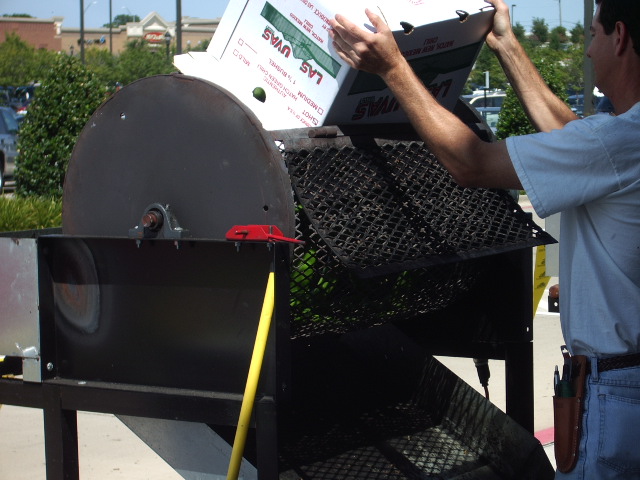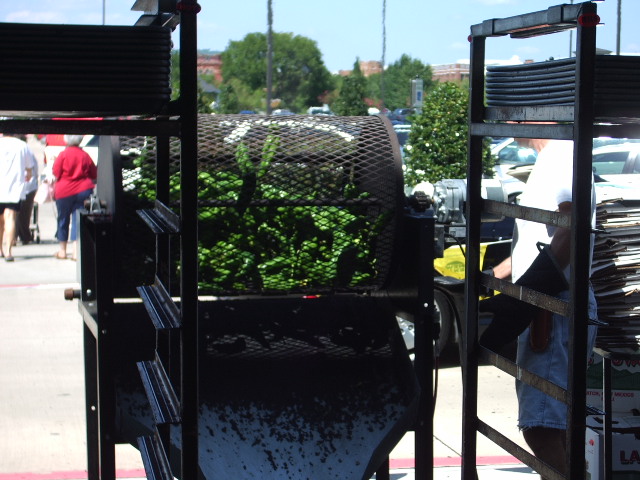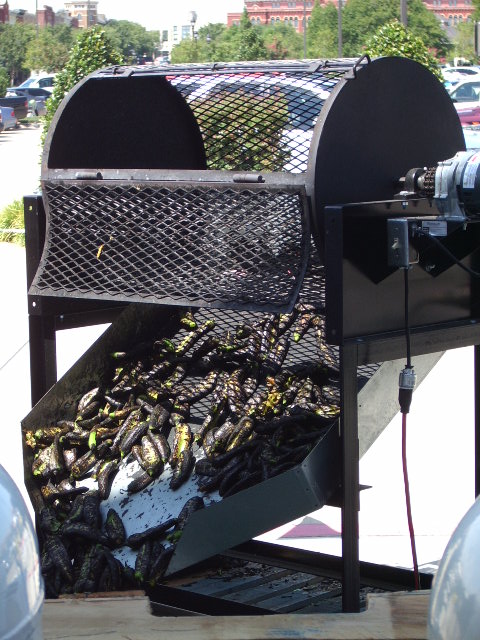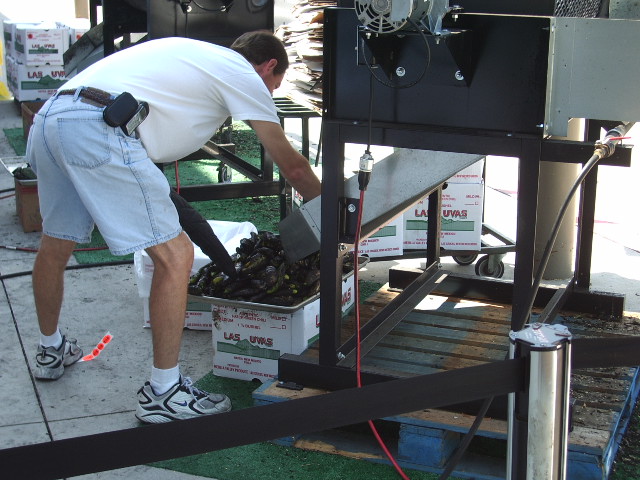-
Posts
6,424 -
Joined
-
Last visited
Content Type
Profiles
Forums
Store
Help Articles
Posts posted by Richard Kilgore
-
-
I went to Main Street in Euless once this summer. The brisket was fatty and I gave it a 5 - 6 on a 10 point scale. Two other former (more recent) Austinites were with me, however, and they gave it a 3, but agreed it would probably be a 5 - 6 in this area. I may try again, after all this was only one visit, but would not make a special trip.
-
I think Mesquite is a traditional fuel for smokers and grills here in Texas, but I have come to prefer milder woods such as apple, especially for pork.
What do you all use? Different wood for different meat, fish and foul?
Briquettes or chunk charcoal? I have been using chunk, but find a lot of unusable small grains in some brands.
-
Has anyone been to F-M 1410 recently? What's available now?
-
Not stock up on Japanese greens in general, but I think you would really like Houjicha. Roasted, not astringent, not bitter and low, low, low caffeine.
-
Today I have also been trying to make friends with gyokuro. I have not brewed it before and the good stuff is rather spendy, so I picked up a tiny amount at Central Market. My guess is that it is maybe average quality, though over-priced. But this way I can try to figure out how to brew gyokuro without too high an absolute cost. More on this at some point in the Japanese Green Tea topic. For now, vegetal-grassy, not particularly sweet, a little astringent and I am certainly not finding its sweet spot, if it has one. If I can get this to work for me I'll consider the better quality versions later. Well, if I can't get this one to work for me, I'll also have to consider a better one.
-
This morning it is the Assam Panitola Estate, Whole Leaf from Tea Source. It seems particularly good today.
-
I usually include banana in addition to whatever other fruiits I am throwing in, as well as yougurt and a teaspoon or so of honey. You can add a little spice, too, such as cinnamon.
-
Started off the day with the last of my a Mariage Frères Ceylon Pettiagala from The Cultured Cup. Hot. But I have made it as iced tea and it is a smooth one that some use as a base for flavoring.
-
I agree, Helen, it is kind of weird, though nice to have the aroma while brewing, and I would not put anything else in it. Another plus is that it's more attractive than the simple glazed kyusu it replaced. I assume it's not really catching on in Japan as a general green tea use kyusu...or maybe even for the roasted teas. Someday perhaps I'll pit it against an inexpensive unglazed kyusu, but I am content with this for now.
-
A number of Indian markets have opened in the last couple of years. There is a newish one I have shopped at several times in recent months in Irving's Valley Ranch area, on McArthur Blvd. There may be larger ones in the DFW area, but this is the largest I have seen.
What other noteworthy Indian grocery markets can anyone recommend?
-
I have used this teapot for a while and think it is great for houjicha and genmaicha. Not necessary, of course if you have a glazed kyusu that you use for all Japanese green teas, but a nice option. This way I keep these potent teas away from unglazed pots that are reserved for such as sencha, kukicha and gyokuro.
-
This morning enjoyed the Assam Sree Sibari Estate from TeaSource.com featured in a recent Tea Tasting & Discussion.
This evening, unwinding with an Organic Kumamoto Yabe Hojicha from kuuki-cha.com that was included as a complimentary gift with a futanashi kyusu, an open Japanese teapot (no, I am not kidding - lidless).
So, what are tea are you drinking today?
-
Yesterday did two gong fu cha brewings of pu-erh teas from Yunnan Sourcing. First a 2005 Yong Pin Hao Stone Pressed Yi Wu Mountain tea cake (sheng, raw) and then a 2003 CNNP Yellow Mark Ripe tea cake. More on these two in the Pu-erh Tea topic.
Also brewed a very fine Kagoshima Sencha Yutaka Midori from O-Cha.com. More on this later in the Japanese Green Tea topic.
How about all of you? What tea have you been drinking?
-
It is best to not break the leaves any more than you have to, so separate the compressed leaves with a pu-erh pick or an ice pick. A mix of chunks and the smaller pieces that usually fall off is usually good for the flavor. Perhaps 80% larger chunks.
A 20 second rinse or two should be sufficient to wash the leaves and flush off debris. Then a 30 to 60 second rest will let the leaves begin to open up a bit. So you can try one rinse and a rest and then see if it brews an infusion to your liking.
Beyond that, each brief infusion will allow it to open up further and release more and often different flavors.
Hope that helps.
-
The second pu-erh is a 2003 CNNP Yellow Mark Ripe Tea Cake sample, also from Yunnan Sourcing on eBay.
Vintage: Spring 2003
Produced under the authority of the CNNP (China National Native Produce and Animal By-Products Import and Export Corporation)
Menghai area ripe pu-erh tea blend.
Brewed 7 g in pre-heated 170 ml Yixing (clay from the 1970s - 90s) filled to about 150 ml level with 212 F water.
Rinse 20 sec X 1, rest 30 sec.
1: 05 - brown-gold liquor, earthy, medium creamy mouthfeel, very slight sweetness.
2: 10 - darker liquor, thicker mouth feel, earthy dominant over sweetness, faint astringency and bitterness (which may be in the pot clay due to brewing a very bitter sheng recently).
3:20 - smoother still, medium creamy mouth feel, decreased earthiness, but still present.
Many infusions left in this, but I stopped at this point, since Wholemeal Crank is right - only so much tea you can drink in a day. Plus, three to five infusions will usually tell you what you want to know initally about a new tea leaf.
I think this is an okay, but not great, everyday shu that is fairly priced. It has no off aromas or flavors, is earthy, smooth and creamy.
YMMV - tasting notes or reviews like this are best considered to be just one more data point. Just because one person likes or dislikes a tea, that may or may not be similar to what you get out of it. Too many variables in brewing and differences in taste and taste preferences.
-
Two pu-erhs today, one a sheng and one a shu, both from Yunnan Sourcing 25 mg samples.
First a 2005 Yong Pin Hao Stone Pressed Yi Wu Mountain tea cake (sheng, raw)
Source: Yong Pin Hao Tea Factory
Varietal: Yi Wu (Mengla) Yunnan large leaf, sun-dried
Scroll down on the listing to see a photo of the type of stone press they use to produce these cakes.
Dry leaves: mild camphor
7 g in a 120 ml (to the lid rim) gaiwan
Rinse 20 sec X 2, Rest 30 sec
1: 7 - Temp - just off boil (est 110 F), medium yellow color, camphor, vague fruit, could have started this infusion longer.
2: 15 - Temp 205 F, astringent, vegetal
3: 30 - Temp 212 F, astringent, fruit over vegetal
4: 20 - I pulled back to 20 sec thinking I may be pushing this to hard and getting more astringency as a result. Temp - 212 F, astringency less in your face, a little vegetal-bitter, plus some component I cannot quite identify. I don't find the nutty taste Yunnan Sourcing mentions.
There is also an underlying mild sweetness in this tea that I did not note above. I think it helps balance the vegetal- mild bitterness.
I don't care for this enough to order a cake, but I am now curious about other older ones from this producer and may order a couple of samples.
-
technogypsy - welcome! I enjoy the stuffed tangerines, too.
Have you developed a taste for certain pu-erhs? Shu (ripe) or sheng (raw) in general? Aged?
-
It's the last day of the Hatch Chile Festival at Central Market stores. They have been roasting huge quantities of Hatch chile peppers from New Mexico since last weekend, and I have been eating Hatch chiles in a little of everything since then.
These photos were taken at the South Lake store. There were three of these rotary pepper grillers going most of the time.




-
A very ambitious tea Saturday!
This is a nice selection of ripe pu-erh to taste, and I agree with the Harney guide that side by side comparisons are a fine way to develop your tea palate. I am curious, though, as to the 0.1 g per 30 ml ratio? Was that a Harney suggestion? It's less than a third the strength for western style brewing and about 1/15 to 1/20th the strength for usual gong fu strength.
-
Jenni, you may find this Indian Tea topic of interest, as well as the Tea Tasting Discussions in this forum that feature Indian teas.
Thanks, but I was merely pointing out the specific way of brewing tea in India, not the different types of tea.
Yes, more on that in a number of posts in the DIY Chai topic.
-
That's true, and exploring samples of young shu and sheng is an adventure and interesting even though all will not be to any one person's taste.
That bamboo sheng is a particularly easy one to like.
-
It's true that Greg at norbutea has sourced some very accessible young sheng. However, I am not surprised that you found the Lao Mansa too bitter given your super-bitter-detector. It's a quality mao cha and I like it fine, keeping in mind that it's a young sheng, but this would be one to put away for ten years.
-
Jenni, you may find this Indian Tea topic of interest, as well as the Tea Tasting Discussions in this forum that feature Indian teas.
-
That's quite a little project, WmC. Given your sensitivity to bitter notes, I don't think you would be able to tolerate many young sheng at all if you brewed then gong fu style. But you may find it interesting to try that sometime with sheng that's at least 10 years old and with shu, at least a year or two old - at least five would be better.



What Tea Are You Drinking Today? (Part 1)
in Coffee & Tea
Posted
Today I started with a nice Assam. This afternoon I began a gong fu cha session with a Spring 2009 Huang Jin Gui from norbutea.com. It's a very nice Anxi Oolong cousin of TGYs. More on this soon in the Oolong topic.